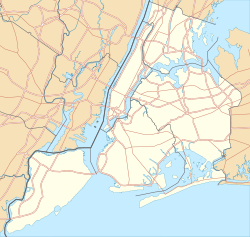The National Register of Historic Places listings in Syracuse, New York are described below. There are 111 listed properties and districts in the city of Syracuse, including 19 business or public buildings, 13 historic districts, 6 churches, four school or university buildings, three parks, six apartment buildings, and 43 houses. Twenty-nine of the listed houses were designed by architect Ward Wellington Ward; 25 of these were listed as a group in 1996.
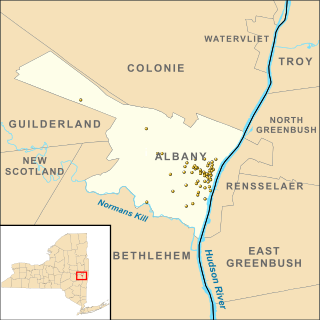
There are 73 properties listed on the National Register of Historic Places in Albany, New York, United States. Six are additionally designated as National Historic Landmarks (NHLs), the most of any city in the state after New York City. Another 14 are historic districts, for which 20 of the listings are also contributing properties. Two properties, both buildings, that had been listed in the past but have since been demolished have been delisted; one building that is also no longer extant remains listed.

Forest–Norman Historic District is a national historic district in Ridgewood, Queens, New York. It includes 37 contributing buildings built between 1908 and 1910. They consist of two-story brick houses with one apartment per floor and two-story brick tenements with two apartments per floor.
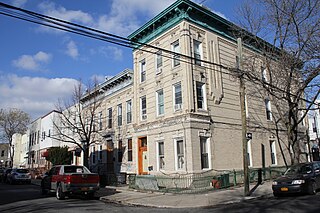
Grove–Linden–St. John's Historic District is a national historic district in Ridgewood, Queens, New York. It includes 51 contributing buildings built between 1908 and 1910. They consist of three story brick tenements with two apartments per floor. There are also a number of two- and three-story row houses with one apartment per floor. The buildings feature Romanesque Revival style detailing.
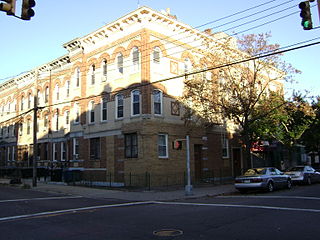
Seneca–Onderdonk–Woodward Historic District is a national historic district in Ridgewood, Queens, New York. It includes 211 contributing buildings built in 1911–1912. They consist mainly of three story brick tenements with two apartments per floor. The buildings feature amber brick facades with burnt orange brick bases and trim.

Woodbine–Palmetto–Gates Historic District is a national historic district in Ridgewood, Queens, New York. It includes 91 contributing buildings built between 1908 and 1911. They consist mainly of three story brick tenements with two apartments per floor. The buildings feature amber brick facades with burnt orange brick bases and trim.

75th Avenue–61st Street Historic District is a national historic district in Glendale, Queens, New York. It includes 183 contributing buildings built between 1910 and 1925. They consist mainly of two story brick row houses with one apartment per floor. Building features include round and box front dwellings, cast stone detailing, brownstone stoops, pressed metal cornices, and covered porches.

68th Avenue–64th Place Historic District is a national historic district in Ridgewood, Queens, New York. It includes 46 contributing buildings built between 1909 and 1913. They consist mainly of two story brick row houses with one apartment per floor. Buildings feature alternating yellow, amber, brown and burnt orange speckled brick and cast stone detailing in the Romanesque Revival style.

Central Avenue Historic District is a national historic district in Glendale, Queens, New York. It includes 104 contributing buildings built in 1916. They consist of three story brick tenements with two apartments per floor. Buildings feature front facades and amber iron-spot brick.

Central Ridgewood Historic District is a national historic district in Ridgewood, Queens, New York. It includes 990 contributing buildings built between 1895 and 1927. They consist mainly of two-story, brick rowhouse dwellings with one apartment per floor. Buildings feature rounded bay front facades and the use of several shades of speckled brick.
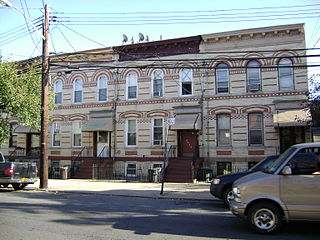
Cooper Avenue Row Historic District is a national historic district in Glendale, Queens, New York. It includes seven contributing buildings built in 1915. They consist of two story, flat front brick rowhouse dwellings with one apartment per floor. They are constructed of yellow brick with burnt orange brick details. They feature some of Glendale's most striking and elaborate brickwork.

Cypress Avenue East Historic District is a national historic district in Ridgewood, Queens, New York. It includes 247 contributing buildings built between 1900 and 1914. They consist mainly of three story tenements with two apartments per floor. They feature alternating facades of light and dark speckled brick.

Cypress Avenue West Historic District is a national historic district in Ridgewood, Queens, New York. It includes 440 contributing buildings built between 1888 and 1906. They consist mainly of brick two and three story row houses with one apartment per floor and three story tenements with two apartments per floor. Also included in the district is Public School #81, St. John's Ridgewood United Methodist Church, and a row of commercial buildings. They feature Romanesque Revival style applied detailing.

Fresh Pond–Traffic Historic District is a national historic district in Ridgewood, Queens, New York. It includes 197 contributing buildings built between 1914 and 1921. They consist mainly of brick two story row houses with one apartment per floor. They have flat or rounded fronts with cream colored or amber, iron spot brick.

The Madison–Putnam–60th Place Historic District is a national historic district in Ridgewood, Queens, New York. It includes 145 contributing buildings built between 1900 and 1920. They consist mainly of brick two story row houses with one apartment per floor and three story tenements with two apartments per floor. They feature brick facades and Romanesque Revival style detailing. Also included in the district is the Old Queens Labor Lyceum.

Seneca Avenue East Historic District is a national historic district in Ridgewood, Queens, New York. It includes 120 contributing buildings built between 1900 and 1915. They consist mainly of brick two story row houses with one apartment per floor and three story tenements with two apartments per floor. They feature speckled brick facades in various shades of yellow, amber, burnt orange, brown, and cream.

Stockholm–DeKalb–Hart Historic District is a national historic district in Ridgewood, Queens, New York. It includes 79 contributing buildings built between 1900 and 1915. They consist mainly of brick two-story row houses with one apartment per floor. Some buildings feature three bay wide wood porches with Tuscan columns.
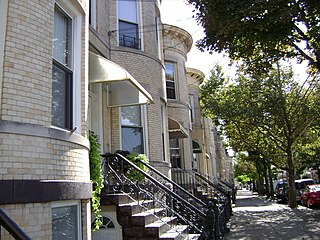
Summerfield Street Row Historic District is a national historic district in Ridgewood, Queens, New York. It includes 19 contributing buildings built in 1912. They are brick two story row houses with one apartment per floor. They feature round bays and yellow iron-spot brick facades.

The Putnam-Parker Block, also known as City Square, are historic structures located in downtown Davenport, Iowa, United States. The property is three buildings that take up the south half of block 43 in what is known as LeClaire's First Addition. The main façade of the structures face south along West Second Street. They were listed on the National Register of Historic Places in 2011. In 2020 it was included as a contributing property in the Davenport Downtown Commercial Historic District. The former Putnam Building now houses a Marriott Autograph Collection hotel named The Current Iowa.
Louis Berger & Co. was an architectural firm in Queens, New York active between 1895 and 1930. It was a major local architect of Ridgewood, Queens.

